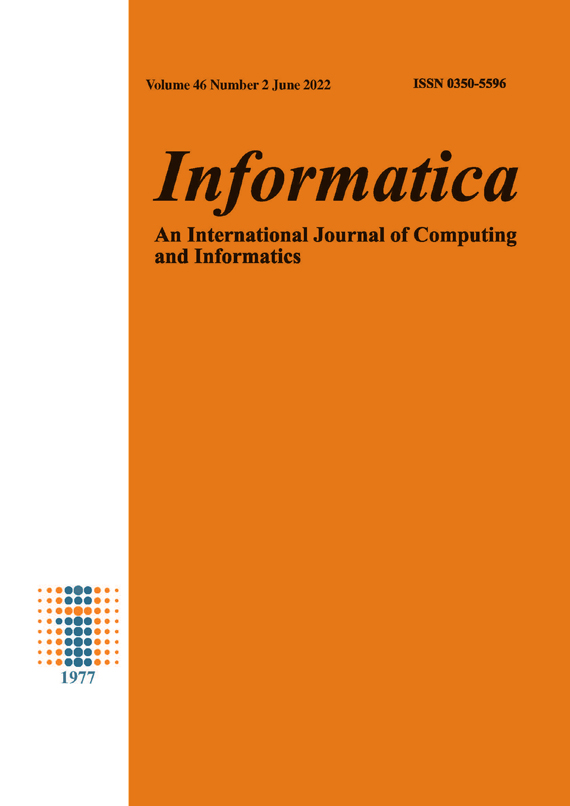Deep Reinforcement Learning-based anomaly detection for Video Surveillance
DOI:
https://doi.org/10.31449/inf.v46i2.3603Abstract
The anomaly detection in automated video surveillance is considered as one of the most critical tasks to be solved, in which we aim to detect a variety of real-world abnormalities. This paper introduces a novel approach for anomaly detection based on deep reinforcement learning. In recent years, deep reinforcement learning has been achieving a significant success in various applications with data of a high degree of complexity such as robotics and games, by mimicking the way humans learn from experiences. Generally, the state-of-the-art methods classify a video as normal or abnormal without pinpointing the exact location of the anomaly in the input video due to the unlabeled clip-level data in training videos. We focus on adapting the prioritized Dueling deep Q-networks to the anomaly detection problem. This model learns to evaluate the anomaly in video clips by exploiting the video-level label to obtain a better detection accuracy. Extensive experiments on 13 cases class of real-word anomaly show that our DRL agent achieved a near optimal performance with a high accuracy in the real world video surveillance system compared to the state-of-the-art approaches.References
S. Ji, W. Xu, M. Yang, and K. Yu (2013) 3d convolutional neural networks for human action recognition, IEEE Trans, Pattern Analysis and Machine Intelligence.
K. Simonyan and A. Zisserman (2014) Two stream convolutional networks for action recognition in videos, NIPS.
A. Karpathy, G. Toderici, S. Shetty, T. Leung, R. Sukthankar, and L. Fei-Fei (2014) Large-scale video classification with convolutional neural networks, CVPR.
C. Schuldt, I. Laptev, and B. Caputo, Recognizing human actions: A local svm approach, in IEEE ICPR, 2004.
M. Ryoo and J. Aggarwal (2009) Spatiotemporal relationship match: Video structure comparison for recognition of complex human activities, ICCV, pp. 15931600.
W. Hu, D. Xie, Z. Fu, W. Zeng, and S. Maybank (2007) Semantic-based surveillance video retrieval Image Processing, IEEE Transactions, vol. 16, no. 4, pp. 11681181.
Meina Qiao, Tian Wang, Jiakun Li, Ce Li, Zhiwei Lin, and Hichem Snoussi (2017) Abnormal event detection based on deep autoencoder fusing optical flow, Control Con-
ference (CCC) 36th, IEEE, Chinese, pages 1109811103.
Ali Khaleghi and Mohammad ShahramMoin (2018) Improved anomaly detection in surveillance videos based on a deep learning method. 2018 8th Conference of AI &
Robotics and 10th RoboCup Iranopen International Symposium (IRANOPEN), IEEE, pages 7381.
Yong Shean Chong and Yong Haur Tay (2017) Abnormal event detection in videos using spatiotemporal autoencoder, International Symposium on Neural Networks, Springer, pages 189196.
M. Hasan, J. Choi, J. Neumann, A. K. RoyChowdhury, and L. S. Davis (2016) Learning temporal regularity in video sequences, CVPR.
Waqas Sultani, Chen Chen, and Mubarak Shah (2018) Real-world anomaly detection in surveillance videos, Center for Research in Computer Vision (CRCV).
Min-hwan Oh, Garud Iyengar (2020) Sequential Anomaly Detection using Inverse Reinforcement Learning, arXiv:2004.10398v1[cs.LG].
Ziyu Wang, Tom Schaul, Matteo Hessel, Hado van Hasselt, Marc Lanctot and Nando de Freitas (2016) Dueling Network Architectures for Deep Reinforcement Learning,
arXiv:1511.06581v3[cs.LG].
V. Mnih, K. Kavukcuoglu, D. Silver, A. A. Rusu, J. Veness, M. G. Bellemare, A. Graves, M. Riedmiller, A. K. Fidjeland, G. Ostrovski, et al (2015) Human-level control through deep reinforcement learning, Nature, 518(7540):529533.
Mnih, V., Kavukcuoglu, K., Silver, D., Graves, A., Antonoglou, I., Wierstra, D., Riedmiller, M., (2013) Playing atari with deep reinforcement learning, arXiv preprint
arXiv:1312.5602.
X. Lan, H. Wang, S. Gong, and X Zhu (2017) Deep reinforcement learning attention selection for person re-identification, BMVC.
D. Tran, L. Bourdev, R. Fergus, L. Torresani, and M. Paluri (2015) Learning spatiotemporal features with 3d convolutional net-works, ICCV.
Tom Schaul, John Quan, Ioannis Antonoglou and David Silver (2016) Prioritizied Experience Replay, arXiv:1511.05952v4 [cs.LG].
Xavier Glorot, Antoine Bordes, Yoshua Bengio (2011) Proceedings of the Fourteenth International Conference on Artificial Intelligence and Statistics, PMLR 15:315-323.
J. Duchi, E. Hazan, and Y. Singer (2011) Adaptive subgradient methods for online learning and stochastic optimization, J. Mach. Learn. Res.
C. Lu, J. Shi, and J. Jia (2013) Abnormal event detection at 150 fps in matlab, ICCV.
Downloads
Published
Issue
Section
License
I assign to Informatica, An International Journal of Computing and Informatics ("Journal") the copyright in the manuscript identified above and any additional material (figures, tables, illustrations, software or other information intended for publication) submitted as part of or as a supplement to the manuscript ("Paper") in all forms and media throughout the world, in all languages, for the full term of copyright, effective when and if the article is accepted for publication. This transfer includes the right to reproduce and/or to distribute the Paper to other journals or digital libraries in electronic and online forms and systems.
I understand that I retain the rights to use the pre-prints, off-prints, accepted manuscript and published journal Paper for personal use, scholarly purposes and internal institutional use.
In certain cases, I can ask for retaining the publishing rights of the Paper. The Journal can permit or deny the request for publishing rights, to which I fully agree.
I declare that the submitted Paper is original, has been written by the stated authors and has not been published elsewhere nor is currently being considered for publication by any other journal and will not be submitted for such review while under review by this Journal. The Paper contains no material that violates proprietary rights of any other person or entity. I have obtained written permission from copyright owners for any excerpts from copyrighted works that are included and have credited the sources in my article. I have informed the co-author(s) of the terms of this publishing agreement.
Copyright © Slovenian Society Informatika








